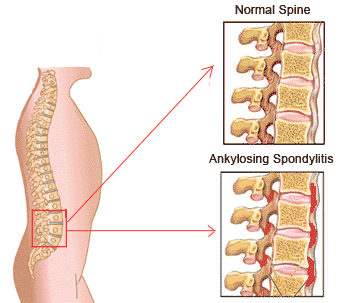
Ankylosing Spondylitis - Overview
‘The young man woke up in the morning with a stiff back and feeling tired – indeed after moving about for some time, his back hurt less, just as his physician had said.’ This is the typical picture of an ankylosing spondylitis patient – whose spine is gradually getting ‘rigid’.
Ankylosing spondylitis affects as many as one to two out of every 1000 males globally; prevalence being much lesser in women. It is a rheumatic disease that causes chronic inflammation of joints (arthritis). The most commonly affected joints affected are those of the spine and the joints between the spine and the pelvis (sacro-iliac joints). The condition ultimately leads to rigidity (‘ankylosis’) of the affected joints on account of abnormal adhesion of the bones in the joint.
Homeopathy can provide good relief to the patients and control the progress of Ankylosing spondylitis. With our proficiency and experience of treating patients for the last 50 years, we can help patients to have good control over this condition and offer them effective and gentle pain control. Ultimately, we strive to give the patients of ankylosing spondylitis a better quality of life, free from the pain of arthritis - one that can be lived to the fullest.
What is Ankylosing Spondylitis?
Fused with pain
Ankylosing spondylitis is derived from the Greek word ankylos meaning fused and spondylos which means vertebrae. Thus it’s a condition in which the ‘spine is fused’ - actually a presentation that is seen in advanced cases of this disease.
Ankylosing spondylitis is an inflammatory disease that affects multiple systems of the body though the commonest affection is of the joints. To make it more precise, the joints of the spine and those between the spine and the pelvis (sacro-iliac) are affected leading to chronic arthritis. Chronic inflammation in these areas causes pain and stiffness that worsens over a period of time.
As the disease progresses, the joints are immobilized on account of the abnormal adhesion (fusion) of the bones in the joints. When this happens to the spine, the condition is called as ‘bamboo spine’ since the spine becomes like one straight column that cannot be bent.
Other joints as well as organs of the body can be affected by this disorder and this includes the eyes, heart, lungs and kidneys.
Ankylosing spondylitis affects males almost two to three times more commonly as compared to females and can affect people of all age groups. However, it tends to present itself around the second to third decade of life.
Ankylosing spondylitis belongs to the group of conditions termed as ‘Seronegative Spondyloarthropathies’. This is because in this condition the Rheumatoid Factor (RF) is absent in the blood (seronegative) and the inflammation or arthritis involves the joints of the spine (spondyloarthropathy).
Causes
Can anyone explain what caused me to land up with this?
An interesting thing about ankylosing spondylitis is that the exact cause of this condition has not been clearly understood till date though it has been the subject of numerous studies!
Ankylosing spondylitis is considered to be a genetic disorder in which the HLA-B27 gene in particular has an important role to play. People with this particular gene have a significantly higher risk of developing ankylosing spondylitis. However, it must be noted that not every person who has the HLA-B27 gene develops this disorder. Thus there are some additional factors, probably environmental, that are involved in the development of this condition.
Patients with a family history of ankylosing spondylitis stand a greater chance to develop it as compared to those with no family history.
In addition, gender predilection has been strongly noticed in this condition. Males are almost 2 to 3 times more prone to develop this condition as compared to females.
The initial inflammation that activates the immune system is thought to be triggered by a bacterial or microbial infection. At a later stage, the immune system is unable to turn off this response which continues to attack the body’s own tissues now, in this case, the joints leading to arthritis. This explains the auto-immune nature of the disease.
Symptoms
“Slowly the pain in the back started, lasted a few days and then suddenly disappeared only to come back again after a few days”.
Gradual progress of ankylosing spondylitis makes it difficult for the patients to exactly pin-point the onset of the ailment. In addition, the initial symptoms are vague such as nagging pain and stiffness (arthritis) in the lower back and hips that has lasted for quite some time. Thus, by the time patients seek treatment, the disease has already progressed to a certain level.
The classical areas that are affected by this condition are:
Symptoms due to the affection of these areas include:
Advanced cases with chronic affection can develop a completely fused spine – here all the joints in between the vertebrae are fused (ankylosed) and the patient develops an inflexible spine. The spine pain or backache usually disappears at this stage. Such a fused spine is very prone to develop fractures due to injury.
During the course of this disease, there are periods when the patient is absolutely free of pain or any complaints (remission) and periods when the disease becomes active again (relapses).
Diagnosis
The earlier Ankylosing Spondylitisis is diagnosed, better is the scope of treatment of the same. This is because ankylosing spondylitis tends to cause structural changes in the joints which may not be possible to reverse if the condition has advanced. The patient’s symptoms are the earliest pointers to this condition. Certain examination findings that help to confirm the diagnosis are:
Investigations generally suggested to the patients: include
Complications
Are these signs I’m getting worse?
Ankylosing spondylitis runs a variable course in most patients with periods of remissions and relapses. The arthritis and other symptoms may gradually worsen over a period of time but most people remain functional unless severely disabled by the pain or immobilized due to fusion of the joints.
The complications of Ankylosing spondylitis vary from patient to patient and some of them are:
Homeopathic Treatment
Effective, soothing pain relief
We have the experience and the expertise of treating patients for the last 50 years and bring smiles to many suffering patients. It's our constant endeavor to impart a better lifestyle to our patients and help them live a pain-free life.
The beauty of Homeopathy is that this science has at least something to offer for most of the ailments. Likewise, even in Ankylosing Spondylitis, Homeopathy can offer significant pain relief to the patients. This holds especially true for cases that are in the early stages of the disease. At this stage, the medication can even help in slowing down the progress of the disease besides offering pain control.
As far as advanced cases are concerned where arthritis has advanced and immobilization of the joints has already occurred, there is nothing much that can be done for the patient except palliating the pain.
Timely treatment can prevent the onset of complications and can also prevent the disease from spreading to involve other organs of the body. In addition, the treatment can also help the patients to manage the feelings of depression, anxiety, withdrawal that many of them suffer from.
Regular exercises, swimming, breathing exercises, gentle stretches, etc. done under the supervision of a physiotherapist combined with Homeopathy can give good results in most cases.
Self Care
Ankylosing spondylitis patients usually face many periods of ups and downs during the course of the disease - there are days when the disease gets troublesome and times when they don’t even realize anything's wrong. However, making certain changes in their lifestyle can take them a long way and help them to deal more effectively with their arthritis and other symptoms. Based on our experience of treating many patients over the last 50 years at Dr. Khullar, we have found that the following can be helpful to patients of ankylosing spondylitis; these tips have a scientific backing and have also been repeatedly verified at the clinic level:

